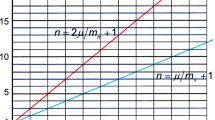Abstract
A long range potential the so-called general particle transfer (GPT) potential was proposed for three-body systems almost one decade ago. In this report, we will illustrate another GPT feature from the dispersion theoretical point of view. The index number of the long range potential is related to the exchange particle mass which represents the threshold of multi-pion creation in the potential cut. The index number is proportional to the exchange particle mass. Therefore, the potential with a large exchange particle mass is negligible compared to that with a small mass. Since the quasi-two-body form factors are also given by the GPT potential, then the GPT potential is represented not by a linear form but by an entangled non-linear long range potential. This results in a long range three-body Efimov-type potential.

Similar content being viewed by others
References
S. Oryu, Universal structure of the three-body system. Phys. Rev. C 86, 044001 (2012)
S. Oryu, A new feature of the Efimov-like structure in the Hadron system-long range force as a recoil effect-. Few-Body Syst. 59, 51 (2018). https://doi.org/10.1007/s00601-018-1373-z
Oryu, S., Long-range property in time-dependent interaction with three-body structure and new aspect, Annual Report of Quantum Bio-Informatics Center of Tokyo University of Science, Vol. 5, 26-34,(2010); “Hi-Tech Research Center” National Project for Private Universities supported by MEXT in 2006
S. Oryu, Long range potential component in the NN force. Few-Body Syst. 54, 283–286 (2013)
S. Oryu et al., A new horizon of few-body problems: Exact coulomb treatment and the energy-momentum translation of the three-body Faddeev equation. J. Phys. Conf. Ser. 915, 012001 (2017)
Oryu S., A possibility of a long range three-body force in the hadron system, Few-Body Syst. “New Trends in Hadron Physics: a Few-Body Perspective” (2020)
V. Efimov, Energy levels arising from resonant two-body forces in a three-body system. Phys. Lett. B 33, 563 (1970)
V. Efimov, Energy levels of three resonantly interacting particles. Nucl. Phys. A 210, 157 (1973)
T. Kraemer, M. Mark, P. Waldburger, J.G. Danzl, C. Chin, B. Engeser, A.D. Lange, K. Pilch, A. Jaakkola, H.-C. Naegerl, R. Grimm, Evidence for Efimov quantum states in an ultracold gas of caesium atoms. Nature 440, 315–318 (2006)
A.F. Nicholson, Bound states and Scattering in an \(1/r^{2}\) potential. Australian J. Phys. 15, 174–179 (1962)
E.O. Alt, P. Grassberger, W. Sandhas, Reduction of the three-particle collision problem to multi-channel two-particle Lippmann-Schwinger equations. Nucl. Phys. B 2, 167–180 (1967)
I. Afnan, A.W. Thomas, Modern Three-Hadron Physics, Topics in Current Physics (Springer, Berlin, 1977)
Naidon P. and Endo S., Efimov Physics: a review, arXiv:1610.09805v2 [quant-ph] 7 Apr (2017)
S. Oryu, T. Watanabe, Y. Hiratsuka, M. Takeda, Y. Togawa, An Investigation of the Nuclear Reaction Near the Three-Body Breack-up Threshold: As a Ultra Low Energy Nuclear Synthesis Few-Body Syst. 60–42 (2019)
Acknowledgements
I would like to thank Dr. Takashi Watanabe and Dr. Yasuhisa Hiratsuka for their assistance. The author is grateful to Dr. B. F. Gibson for his continuous encouragement.
Author information
Authors and Affiliations
Corresponding author
Additional information
Publisher's Note
Springer Nature remains neutral with regard to jurisdictional claims in published maps and institutional affiliations.
Rights and permissions
About this article
Cite this article
Oryu, S. The General Particle Transfer Potential in a Range of Physical Systems and its Long Range Component. Few-Body Syst 62, 56 (2021). https://doi.org/10.1007/s00601-021-01638-9
Received:
Accepted:
Published:
DOI: https://doi.org/10.1007/s00601-021-01638-9




